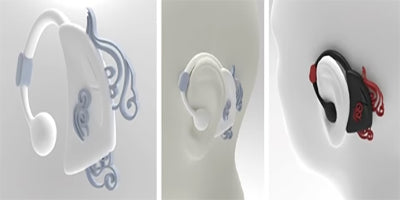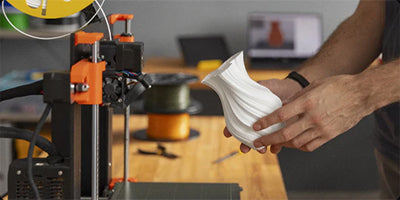Whether it’s sunglasses, shoes, or even VR/AR headsets, an uncomfortable fit for an expensive bit of kit is a no-go for consumers, as recently showcased by Apple Vision Pro buyers citing discomfort as the main reason for returning their shiny new headsets. The one-size-fits-all approach is a rapidly dying ethos in product design, with consumers increasingly searching for customized options to suit their needs.
Previously, this customization level wasn’t possible because the systems to create it didn’t exist at an accessible price point. However, with the increasing affordability of additive manufacturing and 3D scanners, they are now easily accessible to designers, empowering them to create unique, personalized products that cater to individual needs.
In-ear Headphones

Don’t you hate it when your earbuds drop out of your ear? No matter how many different-sized ear tips you try, they just won’t stay put. That’s because ears are unique to every person, much like fingerprints, so if your ears don’t have that particular shape that designers think they should have, you won’t find ear tips that fit you well.
Well, that used to be true, but now, with a quick scan of your ears, a custom set of tips can quickly be made that’ll fit your ear canals perfectly. Even better, scanning the earbud's ear tip connector points can ensure they fit both ends perfectly.
Jewelry

Manually 3D modeling complex organic shapes like flowers, dogs, or butterflies in design software is challenging and time-consuming, often proving a roadblock to creating unique designs. Fortunately, access to 3D scanners wholly demolishes this barrier by making it a cinch to capture complicated objects. Jewelers can also scan a client's neck, finger, or wrist to ensure the piece they create is a perfect fit.
Mobility Aids

3D scanners are much more accurate than conventional body measurement technologies. Scanning a patient’s body allows for the design of prosthetics, custom-fit back braces, and wheelchair seating that fit their unique anatomy perfectly. This ideal fit reduces discomfort and minimizes the chance of complications arising from a lack of decent support and pressure relief while using the aid.
Safety Gear
Those who risk everything to save others deserve to have correctly fitted life-saving gear to give them every advantage in dangerous situations. With the help of 3D scanners like the RANGE 2 for torso scans or MIRACO for both torso and head scans, companies are now creating custom-fit body armor and helmets for law enforcement, military officers, rescue workers, and firefighters.

Cosplay

With at least 5 million people in the US and countless others globally creating and dressing up in outfits from their favorite video games, movies, animes, comics, etc. It’s a serious business, with many cosplayers investing considerable time and money into creating their amazing outfits, so ensuring key outfit pieces fit them comfortably and look great is essential.
And with a helping hand from 3D scanners, they can ensure they do. From capturing body scans for accurate measurements to ensure their outfits comfortably fit to scanning collectible figurines and using the scan data as the basis to design parts of their cosplay outfits.



Laisser un commentaire
Ce site est protégé par hCaptcha, et la Politique de confidentialité et les Conditions de service de hCaptcha s’appliquent.